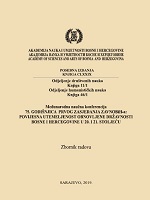JOSIP BROZ TITO, KPJ I BOSNA I HERCEGOVINA 1937-1943. GODINE
JOSIP BROZ TITO, CPY AND BOSNIA AND HERZEGOVINA 1937-1943
Author(s): Ivo Goldstein
Subject(s): Political history, Interwar Period (1920 - 1939), WW II and following years (1940 - 1949), History of Communism
Published by: Akademija Nauka i Umjetnosti Bosne i Hercegovine
Keywords: Josip Broz Tito; CPY; Bosnia and Herzegovina; Federation; Yugoslavia;
Summary/Abstract: The author analyzes the role of Josip Broz Tito and the Communist Party of Yugoslavia in the realization of the idea of a six-member Yugoslav federation, and especially of the place the federative Bosnia and Herzegovina had in this process in years before the Second World War and the first two years of the war, until the second session of AVNOJ in Jajce in November 1943. The policy of the Communist International (Comintern) at the end of the twenties and in the thirties was that the future socialist/communist Yugoslavia must be built on principles different from those of the royal Yugoslavia. Therefore, the socialist Yugoslavia should oppose “monarchy, hegemony and oppression of non-Serb people” (as Tito spoke). The views of Josip Broz Tito on Yugoslav federalism are the logical position of a Croat communist living in Zagreb and witnessing political developments in royal Yugoslavia from Zagreb. Tito has developed a “Croatian variant of Yugoslavism”. For him, the federation was a logical, realistic and concrete solution. In this way, he also saw Bosnia and Herzegovina as an equal member of the federation (though some of his close associates had a different opinion). At the Fifth National Conference of the CPY in Zagreb in October 1940 Tito stated that “Bosnia and Herzegovina is one, because of the traditional common life of the various peoples, regardless of religion”. Then this attitude was further developed and finally realized at the session in Jajce.
- Page Range: 93-113
- Page Count: 21
- Publication Year: 2019
- Language: Croatian
- Content File-PDF

